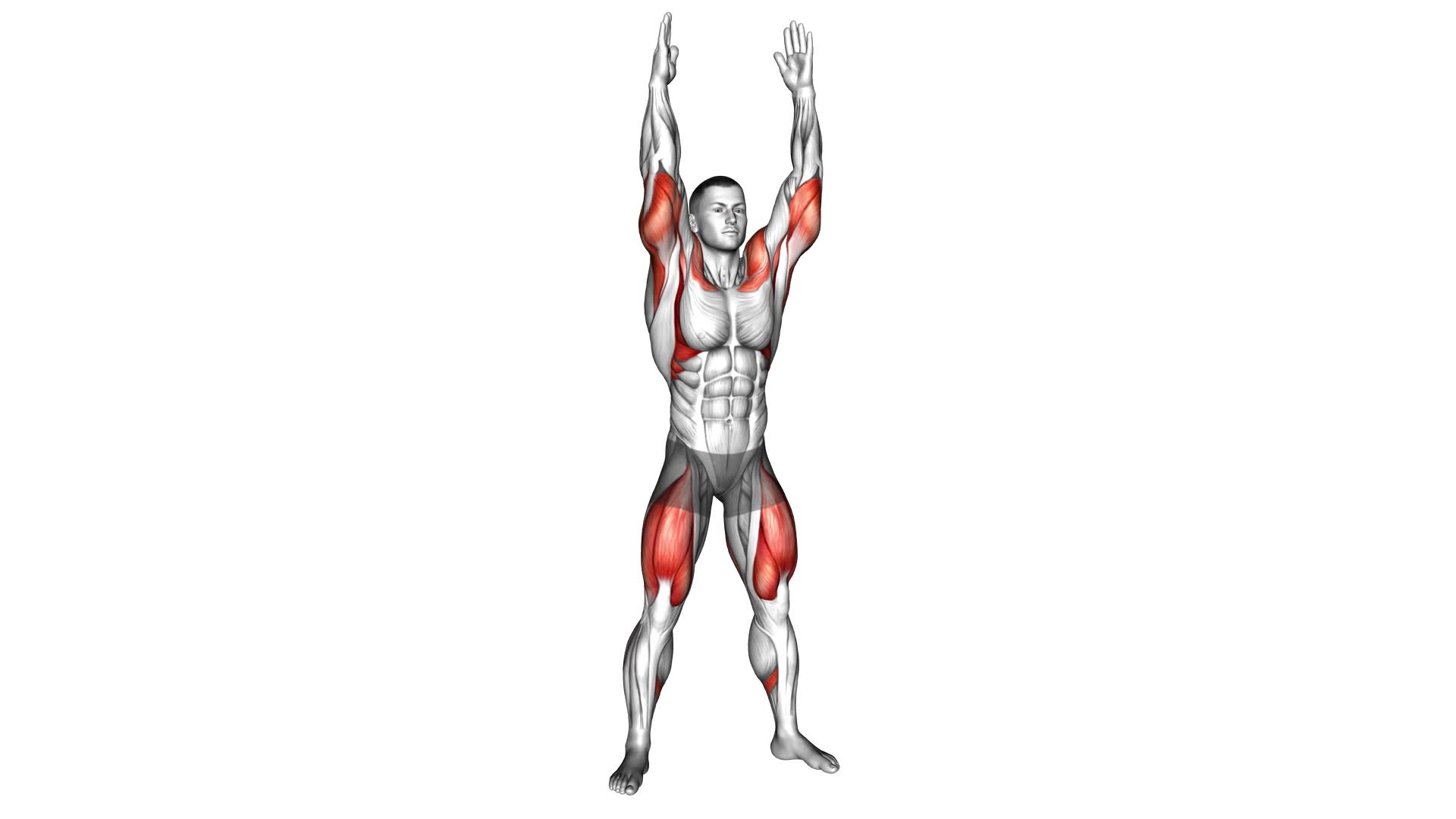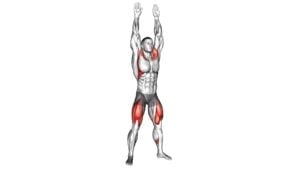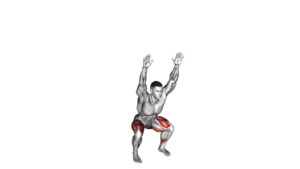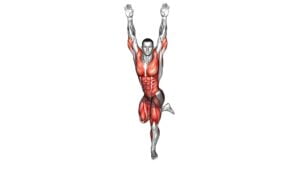Bodyweight Full Squat With Overhead Press (Version 2) – Video Exercise Guide & Tips

Are you looking to level up your workout routine?
Watch This Exercise Video
Then get ready to try the Bodyweight Full Squat With Overhead Press, Version 2.
This exercise combines the power of a squat with the strength-building benefits of an overhead press.
In just a few simple steps, you'll be activating multiple muscle groups and boosting your overall fitness.
Whether you're a beginner or a seasoned fitness enthusiast, this exercise can be modified to suit your needs.
Get ready to take your workout to the next level!
Key Takeaways
- The bodyweight full squat with overhead press targets multiple muscle groups and improves overall strength, stability, and coordination.
- Proper form and technique, such as maintaining a neutral spine and engaging core muscles, are important for performing the exercise effectively.
- Beginners can start with bodyweight squats and overhead presses separately, while advanced fitness enthusiasts can incorporate heavier weights and resistance bands.
- Common mistakes to avoid include knee collapsing inward, improper back alignment, and rounding or hunching over. Maintaining proper form and technique is crucial.
Benefits of the Bodyweight Full Squat With Overhead Press
You can experience numerous benefits from incorporating the bodyweight full squat with overhead press into your workout routine. This exercise not only targets multiple muscle groups but also improves your overall strength, stability, and coordination.
One of the main benefits of this exercise is that it engages your lower body, specifically your glutes, quads, and hamstrings, during the squat movement. This helps to strengthen these muscles and improve your lower body strength. Additionally, the overhead press component of this exercise targets your shoulders, triceps, and upper back, helping to develop upper body strength and stability.
Another benefit of the bodyweight full squat with overhead press is its versatility. This exercise can be modified to suit your fitness level and goals. For beginners, you can start by performing the squat and overhead press separately, using lighter weights or no weights at all. As you progress, you can increase the weight and perform the exercise as one fluid movement. This allows you to continuously challenge yourself and adapt the exercise to your current abilities.
Incorporating the bodyweight full squat with overhead press into your workout routine can also improve your functional fitness. This exercise mimics movements that you perform in everyday life, such as lifting objects overhead or getting up from a seated position. By strengthening the muscles involved in these movements, you can improve your overall mobility and make daily tasks easier.
Proper Form and Technique for Version 2
To perform the bodyweight full squat with overhead press (Version 2) correctly, focus on maintaining proper form and technique throughout the exercise. Here are some key points to keep in mind:
- Benefits of proper alignment: Maintaining proper alignment during the exercise helps to maximize muscle activation and prevent injuries. It ensures that the joints are in the correct position, reducing the strain on them and allowing for a more efficient movement.
- Increasing weight load: As you become more proficient in this exercise, you can gradually increase the weight load to continue challenging your muscles. This can be done by using dumbbells or a barbell during the overhead press portion of the movement.
- Maintain a neutral spine: Keep your spine straight throughout the entire exercise. Avoid excessive arching or rounding of the back, as this can put unnecessary stress on the spine and increase the risk of injury.
- Engage your core: Activate your core muscles by drawing your belly button in towards your spine. This helps to stabilize your body and maintain proper alignment during the movement.
- Controlled movement: Perform the exercise in a slow and controlled manner. Avoid using momentum to lift the weight, as this diminishes the effectiveness of the exercise and increases the risk of injury.
By focusing on proper form and technique, you can reap the full benefits of the bodyweight full squat with overhead press (Version 2).
Now, let's move on to the next section, which discusses modifications for beginners and advanced fitness enthusiasts.
Modifications for Beginners and Advanced Fitness Enthusiasts
For beginners and advanced fitness enthusiasts, there are various modifications available to tailor the bodyweight full squat with overhead press (Version 2) to your individual fitness level.
If you're just starting out, it's important to focus on proper form and technique before progressing to more advanced modifications. For beginners, it's recommended to start with bodyweight squats and overhead presses separately, mastering each movement before combining them. This will help you develop the necessary strength and stability in your lower body and upper body before attempting the full exercise.
Additionally, you can use lighter weights or resistance bands to decrease the load and intensity of the exercise. As you become more comfortable and confident with the movement, you can gradually increase the weight and resistance to challenge yourself and progress to more advanced modifications.
Advanced fitness enthusiasts can modify the exercise by using heavier weights or resistance bands to increase the intensity and challenge their muscles further. They can also try incorporating variations such as single-leg squats or explosive jumps to add an extra level of difficulty and engage different muscle groups.
Remember to always listen to your body and adjust the modifications according to your individual abilities and fitness goals.
Common Mistakes to Avoid
When performing the Bodyweight Full Squat with Overhead Press, there are a few common mistakes you need to avoid.
One of these mistakes is knee collapsing inward, which can put unnecessary strain on your joints and increase the risk of injury.
Another mistake to watch out for is improper back alignment, as this can lead to poor form and limit the effectiveness of the exercise.
Knee Collapsing Inward
Avoid knee collapse while performing the bodyweight full squat with overhead press by maintaining proper alignment and stability. When your knees collapse inward, it can lead to decreased knee stability and improper muscle activation. To prevent this common mistake, follow these tips:
- Engage your glutes and core to maintain stability throughout the movement.
- Keep your knees in line with your toes as you descend into the squat.
- Push your knees outwards to prevent them from collapsing inward.
- Focus on distributing your weight evenly through your feet.
- Maintain proper form and technique throughout the exercise.
By avoiding knee collapse, you can ensure optimal knee stability and activate the correct muscles during the bodyweight full squat with overhead press.
Now let's move on to the next section and discuss the importance of proper back alignment.
Improper Back Alignment
To maintain proper back alignment during the bodyweight full squat with overhead press, focus on keeping your spine straight and engaged throughout the exercise. Proper back alignment is crucial for injury prevention and maximizing the effectiveness of this exercise.
One common mistake to avoid is rounding your back or hunching over during the movement. This can put excessive strain on your spine and increase the risk of injury. Instead, maintain a neutral spine by engaging your core and keeping your chest lifted.
Imagine a straight line from your head to your tailbone throughout the entire exercise. By maintaining proper back alignment, you can protect your spine and ensure that you're getting the most out of your workout.
Tips for Increasing Intensity and Progression
To increase the intensity and progression of the Bodyweight Full Squat With Overhead Press (Version 2) exercise, incorporate additional resistance for a more challenging workout. Here are some tips on how to do it effectively:
- Use dumbbells or kettlebells: Hold a dumbbell or kettlebell in each hand while performing the exercise. This will increase the load on your muscles and make the movement more challenging.
- Increase the weight: Gradually increase the weight of the dumbbells or kettlebells as you get stronger. Start with a weight that allows you to perform the exercise with proper form, and then progress to heavier weights over time.
- Try a barbell: Instead of using dumbbells or kettlebells, you can also use a barbell to add resistance. Hold the barbell on your shoulders, with your hands slightly wider than shoulder-width apart, and perform the exercise as usual.
- Incorporate advanced modifications: Once you have mastered the basic version of the exercise, you can try more advanced modifications to further increase the intensity. For example, you can perform the exercise on an unstable surface, such as a Bosu ball or a balance trainer, or you can perform the exercise with one leg lifted off the ground.
- Increase the number of repetitions and sets: Instead of increasing the resistance, you can also increase the number of repetitions and sets you perform. This will help to challenge your muscles and improve your overall strength and endurance.
Incorporating the Exercise Into Your Workout Routine
To effectively incorporate the bodyweight full squat with overhead press into your workout routine, you need to understand the benefits of this exercise.
By combining the squat and overhead press, you engage multiple muscle groups, promoting strength and stability.
It's important to maintain proper form throughout the exercise, ensuring that your knees are aligned with your toes and your core is engaged.
To maximize the benefits, consider adding this exercise to your routine 2-3 times a week, alternating with other strength training exercises for a well-rounded workout.
Benefits of Incorporation
You can experience numerous benefits by incorporating this exercise into your workout routine. Here are five key benefits:
- Improved strength and muscle tone: The bodyweight full squat with overhead press engages multiple muscle groups, including the legs, glutes, core, and shoulders. By performing this exercise regularly, you can develop overall strength and achieve a more toned physique.
- Increased cardiovascular endurance: This compound exercise combines lower body strength with an upper body press, elevating your heart rate and improving cardiovascular endurance.
- Enhanced balance and stability: The squatting motion requires stability and balance, which can help improve your overall coordination and reduce the risk of falls or injuries.
- Time-efficient workout: Incorporating this exercise into your routine allows you to work multiple muscle groups simultaneously, saving valuable time during your workouts.
- Functional strength: The movements involved in the bodyweight full squat with overhead press mimic daily activities like lifting objects or reaching overhead, helping to build functional strength that translates into everyday tasks.
Proper Form Techniques
To properly incorporate the bodyweight full squat with overhead press into your workout routine, focus on maintaining proper form and technique. Start by positioning your feet shoulder-width apart and your toes pointing slightly outward. As you descend into the squat, make sure to keep your chest up, back straight, and knees tracking over your toes. Engage your core and glutes to maintain stability throughout the movement.
When performing the overhead press, extend your arms fully overhead while keeping your elbows slightly bent. Remember to exhale as you press the weight overhead and inhale as you lower it back down. It's important to note that a common misconception is to rush through the exercise. Take your time and focus on executing each rep with proper form.
Now, let's move on to workout schedule suggestions to maximize the benefits of this exercise.
Workout Schedule Suggestions
To incorporate the bodyweight full squat with overhead press into your workout routine effectively, consider following these workout schedule suggestions:
- Vary the exercise frequency: Perform the bodyweight full squat with overhead press 2-3 times per week to allow for adequate rest and recovery.
- Alternate exercise variations: Incorporate different variations of the bodyweight full squat with overhead press, such as using dumbbells or a barbell, to challenge your muscles in different ways.
- Prioritize proper form: Focus on maintaining correct form throughout the exercise to maximize its effectiveness and minimize the risk of injury.
- Gradually increase intensity: Start with lighter weights or bodyweight and gradually increase the resistance or load as your strength improves.
- Listen to your body: Pay attention to how your body feels during and after the exercise. If you experience excessive soreness or discomfort, adjust the frequency or intensity accordingly.
Frequently Asked Questions
How Many Calories Can I Expect to Burn With the Bodyweight Full Squat With Overhead Press (Version 2)?
You can expect to burn a significant amount of calories with the bodyweight full squat with overhead press (version 2).
This exercise combines the benefits of both a squat and an overhead press, engaging multiple muscle groups simultaneously.
By incorporating compound movements, your body will work harder, resulting in increased calorie burn.
Additionally, the inclusion of weights or resistance bands can further enhance the intensity of the exercise, leading to even greater calorie expenditure.
Can This Exercise Help Improve My Balance?
Improving your balance is one of the benefits of this exercise. By engaging multiple muscle groups and challenging your stability, the bodyweight full squat with overhead press can help enhance your overall balance.
This exercise requires coordination and control, forcing you to maintain stability throughout the movement. By consistently practicing this exercise, you can improve your ability to stay balanced, which can have a positive impact on your daily activities and athletic performance.
Is It Necessary to Warm up Before Performing the Bodyweight Full Squat With Overhead Press (Version 2)?
Before performing the bodyweight full squat with overhead press (version 2), it's necessary to warm up. Warming up prepares your muscles and joints for the exercise, reducing the risk of injury. It increases blood flow and flexibility, ensuring optimal performance.
Incorporating this exercise into your workout routine offers numerous benefits. It improves lower body strength, upper body strength, and overall stability. By engaging multiple muscle groups, it helps burn calories and promotes muscle growth for optimal results.
Can I Do This Exercise if I Have Knee or Shoulder Injuries?
If you have knee or shoulder injuries, it's important to modify this exercise to avoid further harm. There are alternative exercises you can do that won't put as much strain on those areas.
Consult with a professional or physical therapist who can provide injury modifications specific to your needs. It's crucial to prioritize your safety and well-being while still maintaining an active lifestyle.
How Often Should I Incorporate the Bodyweight Full Squat With Overhead Press (Version 2) Into My Workout Routine for Optimal Results?
For optimal results, you should incorporate the bodyweight full squat with overhead press (version 2) into your workout routine regularly.
The frequency will depend on your fitness level and goals.
Beginners can start by doing this exercise 2-3 times a week, making sure to modify it to suit their abilities.
Advanced lifters can increase the frequency to 4-5 times a week and focus on progressing the exercise by using heavier weights or increasing the number of repetitions.
Conclusion
Incorporating the bodyweight full squat with overhead press (version 2) into your workout routine can provide numerous benefits, such as improving strength, stability, and coordination. By following proper form and technique, avoiding common mistakes, and gradually increasing intensity, you can maximize the effectiveness of this exercise.
Whether you're a beginner or advanced fitness enthusiast, modifications are available to suit your fitness level. So, start incorporating this compound exercise into your routine to enhance your overall fitness and achieve your fitness goals.

Author
Years ago, the spark of my life’s passion ignited in my mind the moment I stepped into the local gym for the first time. The inaugural bead of perspiration, the initial endeavor, the very first surge of endorphins, and a sense of pride that washed over me post-workout marked the beginning of my deep-seated interest in strength sports, fitness, and sports nutrition. This very curiosity blossomed rapidly into a profound fascination, propelling me to earn a Master’s degree in Physical Education from the Academy of Physical Education in Krakow, followed by a Sports Manager diploma from the Jagiellonian University. My journey of growth led me to gain more specialized qualifications, such as being a certified personal trainer with a focus on sports dietetics, a lifeguard, and an instructor for wellness and corrective gymnastics. Theoretical knowledge paired seamlessly with practical experience, reinforcing my belief that the transformation of individuals under my guidance was also a reflection of my personal growth. This belief holds true even today. Each day, I strive to push the boundaries and explore new realms. These realms gently elevate me to greater heights. The unique combination of passion for my field and the continuous quest for growth fuels my drive to break new ground.







